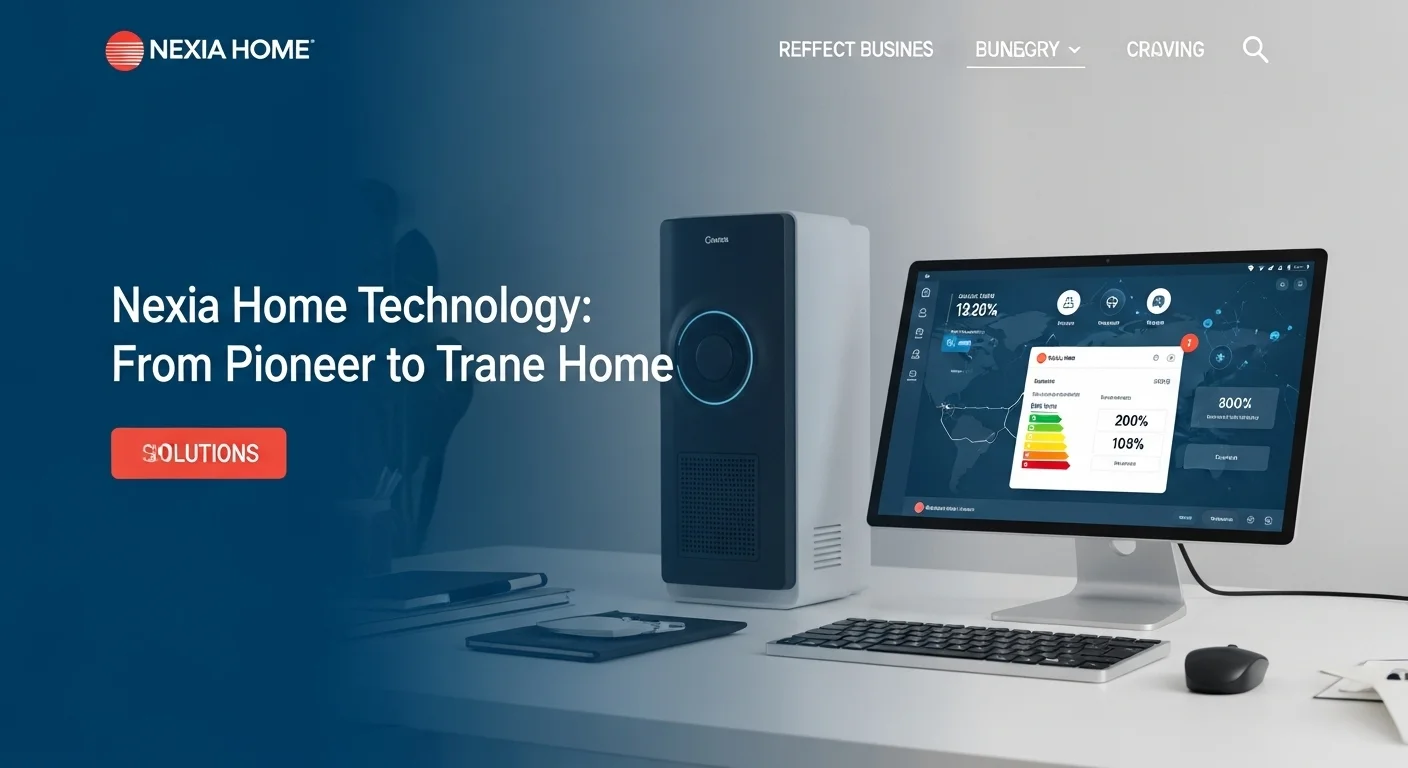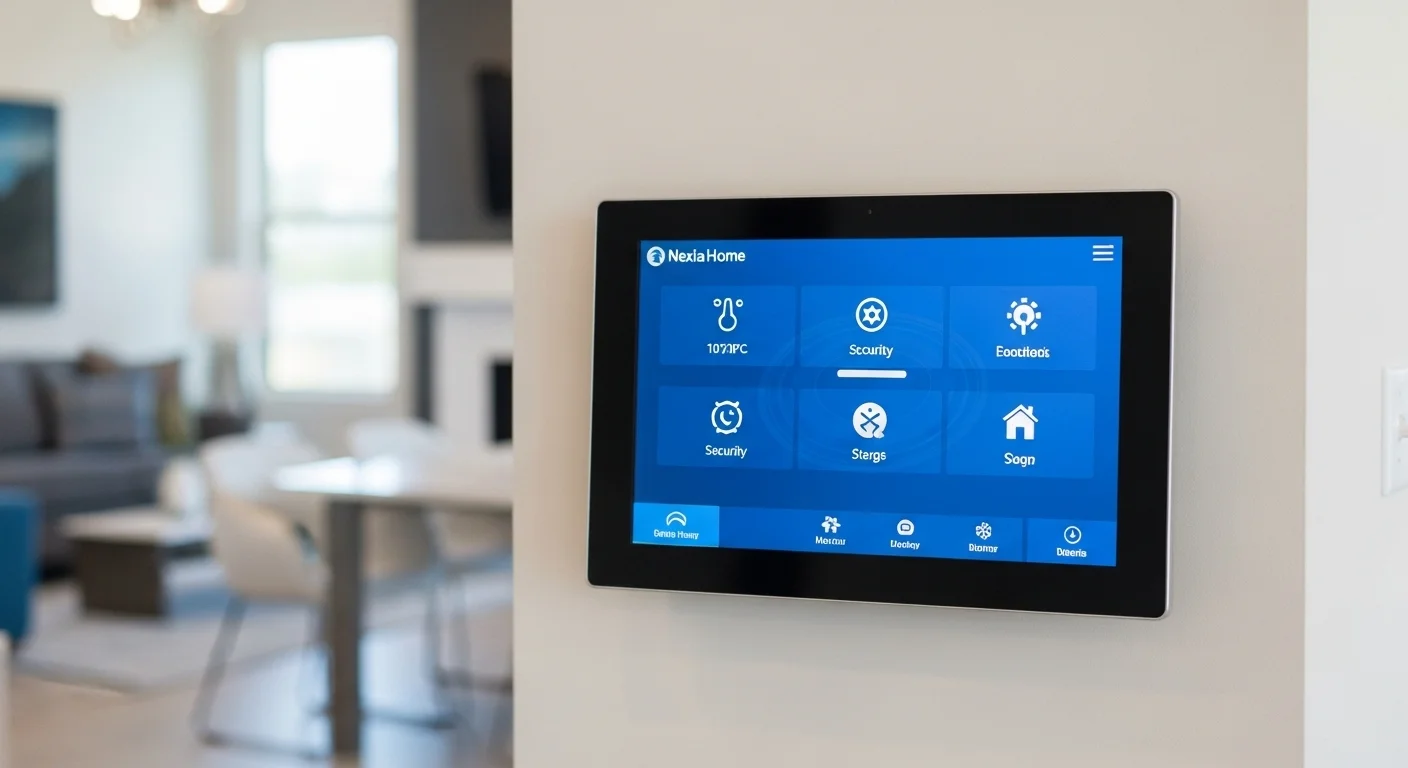The Nexia Story: How a Smart Home Pioneer Became Trane Home

Executive Summary
I've been working with smart home tech since the beginning, and I remember Nexia hitting the scene as a major player. This article is my deep dive into its journey. We'll look at the core ideas behind the Nexia Home Intelligence platform, its smart reliance on Z-Wave technology, and the ecosystem of devices it created. I'll walk you through its crucial rebranding to Trane Home in 2021, a move that brought it closer to its parent company, Trane. We'll break down how the whole system works, from the app in your hand to the cloud and back to your devices, and why this setup is key for both function and security. We’ll cover the full experience, from simple home automation to robust security features. For business owners and fellow tech lovers, I'll share practical uses in property management and how to think about cybersecurity in our connected world. Finally, we'll look ahead at what new standards like Matter mean for the future of smart homes.
Table of Contents
Table of Contents
- What was Nexia Home and Why Was It a Big Deal?
- The Tech Backbone: Why Z-Wave Was the Right Choice
- Creating an Ecosystem: From Automation to Security
- Nexia's Legacy in the Smart Home World
What was Nexia Home and Why Was It a Big Deal?
Back in the early 2000s, the idea of a 'smart home' was just starting to take off. It wasn't about just one gadget; it was about creating a home that could think and act for you. In that early, exciting time, a few platforms stood out, and one of the names I remember well was Nexia Home Intelligence. Even though the name has changed, the foundation it built is still a huge part of how we understand smart homes today.
At its heart, Nexia Home Intelligence was a system designed to bring all your smart devices together. I recall it growing out of the old Schlage LiNK system, which was then expanded by Ingersoll Rand, the powerhouse behind both Schlage and Trane. What made Nexia different was its ambition. It wasn't just an app to control a lightbulb. It was designed to create a complete smart home experience. You could manage your thermostat, door locks, lights, and cameras all from one place—a web portal or a mobile app. This unified approach was a massive leap forward, giving us a real taste of an intelligent, streamlined home. In October 2021, the name officially changed to Trane Home to better connect with its parent brand. For those of us who were already users, the switch was painless; all our settings and devices carried over, but the focus shifted to an even deeper integration with Trane HVAC systems.
The Tech Backbone: Why Z-Wave Was the Right Choice
To make this unified home a reality, the Nexia team made a critical choice: they built their platform on Z-Wave. In my experience, this was a brilliant move. While everyone knew Wi-Fi, Z-Wave had some key advantages for home automation. It uses a different radio frequency, so it doesn't have to compete with your Wi-Fi, cordless phones, or microwave, which means a much more reliable connection. But the real magic of Z-Wave is its mesh network. Think of it like a bucket brigade. Every device plugged into an outlet, like a light switch or smart plug, acts as a signal repeater. If a command can't reach the main hub directly, it just hops from one device to the next until it gets there. This makes the network stronger and more reliable as you add more devices—perfect for a house with all its walls and potential dead spots. The Nexia Bridge was the system's brain, translating signals between your internet and this Z-Wave network, allowing you to connect over 200 different compatible gadgets.
Creating an Ecosystem: From Automation to Security
The real power of the platform was the huge family of devices it worked with, which covered the two main pillars of any good smart home: automation and security.
For home automation, the system was fantastic at creating schedules and routines that just made life easier. You could set your Trane thermostat to automatically adjust when your phone's location showed you'd left for work. You could also link actions together. I loved setting up a 'Welcome Home' routine: unlocking the Schlage smart lock would also turn on the hallway lights and set the thermostat to a comfortable temperature. This was more than just remote control; it was a layer of intelligence that simplified my day.
On the security front, the platform provided a solid, self-monitored system that brought real peace of mind. The foundation was the Schlage smart locks, which let you lock and unlock doors from anywhere and create temporary codes for guests. You could expand the system with sensors for doors, windows, and motion. If a sensor was triggered, you'd get an instant text or email alert. Plus, with integrated cameras, you could pull up a live feed of your home no matter where you were. It didn't have professional monitoring like ADT, but it gave homeowners a powerful and affordable way to keep an eye on things themselves.
Nexia's Legacy in the Smart Home World
I don't think you can overstate Nexia's importance. It helped popularize the subscription model for smart homes, which funded ongoing support and development. It was also a major champion of the Z-Wave standard, helping create a market where devices from different brands could actually work together. By being accessible enough for DIYers like me but also available for pro installation, it filled a major gap in the market. Its evolution into Trane Home shows how the industry has matured. The focus has shifted from novelty to utility, using deep HVAC data to offer proactive maintenance and better energy savings. The journey of Nexia is a great story about the vision of a truly connected, safe, and automated place to live.

Your Complete Guide to Trane Home's Tech and Business Uses
To really get what the Nexia platform, now Trane Home, is all about, you have to look under the hood at its technology, see how it applies to businesses, and take a hard look at its security. In my years of working with these systems, I've seen them used in some amazing ways. This guide will break down the system's architecture, explore its value for commercial use, and put it in context with the competition.
Technical Architecture: A Journey from Your App to Real-World Action
The entire Trane Home system runs on a clear, cloud-based structure. Let’s walk through what happens when you do something simple, like lock your front door from your phone:
- The App: You tap the 'lock' button in the Trane Home app or on the web portal. This is your command center.
- Secure Trip to the Cloud: That command travels over the internet to Trane Home's servers. This connection is encrypted, just like your online banking, so no one can intercept it.
- Cloud Brains: The servers check who you are, make sure you have permission, and process the command. This is the 'intelligence' part of the system, where your account, settings, and automation rules live. It’s a classic example of the Internet of Things (IoT) in action.
- The Return Trip: The server sends the authenticated command back over the internet to your home's router.
- The Bridge: Your router passes the command to the system's hub—either a standalone Nexia Bridge or one built into a Trane thermostat. This little box is the translator between the internet world and the Z-Wave network in your home.
- The Z-Wave Mesh: The Bridge broadcasts the command using the Z-Wave protocol. If your front door lock is too far to hear it directly, the signal hops through other Z-Wave devices until it arrives.
- Action!: The smart lock receives the command and throws the deadbolt. It then sends a 'job done' message back through the same path, and your app updates to show the door is locked.
This whole round trip takes just a few seconds, but it's a beautiful dance between mobile tech, cloud computing, and wireless protocols. It does mean you need an active internet connection for remote control, which is pretty standard for most smart home systems I've worked with.
A Real-Talk Look at Smart Home Cybersecurity
The convenience of a smart home comes with a responsibility to keep it secure. The platform's security isn't just about strong locks; it's about protecting the digital ecosystem. Here's how I break down security for clients:
- Data on the Move: When data travels from your app to the cloud and back, it must be encrypted using standards like Transport Layer Security (TLS). This is non-negotiable.
- Data at Rest: Your personal info stored on the company's servers also needs to be encrypted to protect it from breaches.
- Device-Level Security: Z-Wave itself has security features built in (like the S2 framework) to encrypt signals inside your home, stopping local hacking attempts.
- The Human Factor: Honestly, the biggest risk is often us. Using a weak or reused password for your Trane Home account can make all other protections useless. You have to use strong, unique passwords. It’s the single most important thing you can do.
- Your Home Network: Your Wi-Fi router is the front door to your digital home. If it's not locked, everything inside is vulnerable. Use WPA2 or WPA3 encryption and, for heaven's sake, change the default admin password that came with it.
No system is unhackable, but a layered approach—combining the platform's security with your own good habits—is the best way to keep your smart home cybersecurity safe.
Smart Solutions for Business
The same principles that make a smart home convenient can be a game-changer for businesses.
- Property Management & Vacation Rentals: I've set this up for landlords, and it's a lifesaver. Schlage smart locks mean no more physical keys to track. You can issue temporary digital codes for tenants, guests, or repair crews and see exactly who came and went. Remotely controlling the HVAC saves a fortune on energy bills in empty units.
- Small Offices and Shops: Business owners can automate lighting and thermostat schedules to cut energy costs. Security features let them monitor the property after hours with cameras and sensors. Smart locks can also control access to sensitive areas like a stockroom.
- Elder Care: This is a growing field I'm passionate about. Motion sensors can subtly monitor a senior's activity, alerting family if there's a prolonged lack of movement. Automated lights reduce fall risks at night, and remote locks allow caregivers to enter easily in an emergency.
These examples show that smart platforms like this offer real, tangible value far beyond just a cool gadget for your house.
Where Trane Home Stands and What's Next
Nexia started in a market that's now full of giants like Amazon, Google, and Apple. Its focus on the reliable Z-Wave ecosystem and a curated list of certified devices gave it an edge in stability over more open (and sometimes chaotic) platforms. The rebrand to Trane Home was a smart pivot, doubling down on its unique strength: deep HVAC integration. Getting diagnostic data directly from your furnace or AC is a value proposition that generic platforms can't offer. Looking ahead, the whole industry is moving toward a new standard called Matter, which aims to let all smart devices work together, regardless of brand. Platforms like Trane Home will need to embrace Matter to stay relevant, and I'm watching closely to see how they do it. It’s an exciting time to be in this field.

Practical Tips to Get the Most Out of Your Trane Home System
As someone who has set up and tweaked countless smart home systems, I can tell you that getting the most out of a platform like Trane Home is about more than just plugging things in. It’s about being strategic with your setup and thoughtful with your automations. Here are my go-to tips and strategies to make your system not just functional, but genuinely smart.
Best Practices for a Rock-Solid Smart Home
Before you get fancy with automations, you need a stable base. The performance of your entire system hinges on the strength of its networks.
- Build a Strong Z-Wave Mesh: The reliability of your system lives and dies by its Z-Wave mesh network. I always tell people to place the hub (the Bridge or Trane thermostat) in a central spot, away from big metal appliances. Then, add your devices strategically. Install the powered devices first—things like smart switches and outlets. These act as repeaters and strengthen the network backbone before you add battery-powered sensors that might be further out. A healthy mesh is the secret to a responsive, lag-free system.
- Lock Down Your Wi-Fi: Your Wi-Fi is the gateway from the internet to your home. Securing it is absolutely critical. Use strong WPA3 or WPA2 encryption. The first thing you should do is change the default administrator password on your router. I also recommend setting up a separate guest network for visitors. This keeps their devices off your main network where your smart home gear lives. And please, keep your router's firmware updated for the latest security patches.
- Get to Know the App and Portal: Spend an hour just tapping through the Trane Home app and web portal. Learn where to find device history, check battery levels, and manage your account. The more comfortable you are with the interface, the more you'll discover its powerful features. This is your main control panel, so knowing it inside and out is key.
Level Up Your Life with Smart Automation
Real home automation isn't about remote control; it's about creating routines that match your lifestyle and anticipate your needs. I encourage clients to think in terms of 'scenes'.
- Create Lifestyle Scenes: Instead of controlling one device at a time, bundle actions together.
- 'Goodbye' Scene: With one tap, lock all the doors, arm the security sensors, turn off every light, and set the thermostat to an energy-saving 'Away' mode.
- 'Goodnight' Scene: Lock the doors, dim the hallway lights, confirm the garage is closed, and set your bedroom temperature for a perfect night's sleep.
- 'Movie Night' Scene: Dim the living room lights, turn on the smart plug for your soundbar, and maybe drop the temperature a degree or two. - Use Geofencing: This is one of my favorite 'set it and forget it' features. It uses your phone's location to trigger automations. When you cross a virtual boundary around your home, it can automatically run your 'Welcome Home' scene. When you leave, it can trigger your 'Goodbye' scene. It's powerful, hands-free automation.
- Schedule for Efficiency and Security: For predictable routines, scheduling is perfect. Set your porch lights to turn on at sunset and off at sunrise. Have your thermostat warm the house up just before you get home from work. You can also use this for security when you're on vacation by creating a schedule that turns different lights on and off to make it look like someone's home.
- Link Devices for True Intelligence: The most powerful automations happen when devices trigger each other. For instance, a motion sensor in the hall can turn on the lights to a dim 20% between 11 PM and 6 AM—just enough to see without being blinded. A sensor on the back door triggering after dark could instantly turn on a floodlight. This is where your home starts feeling truly responsive.
Advanced Strategies for the Tech Enthusiast
For those who want to push the system even further, here are a few advanced tips.
- Be Proactive with Security: Don't just set up your security and forget it. Periodically review the access codes on your smart locks and delete old ones. Check the event logs to see if there's any unusual activity. Be mindful of camera placement to ensure security while respecting privacy. Remember, every device is a potential door into your network, so a 'trust but verify' mindset is always a good idea.
- Use Your Voice: Connect your Trane Home account to Amazon Alexa or Google Assistant. The convenience of saying, "Hey Google, lock the front door," or "Alexa, set the AC to 72," is a simple pleasure that you'll use every day.
- Explore IFTTT Integrations: Check if Trane Home connects with services like IFTTT (If This Then That). IFTTT is a powerful tool that lets you link services that don't normally talk to each other. You could create custom recipes for incredibly personalized automations.
- Get Ready for Matter: The smart home industry is slowly but surely moving toward the Matter protocol. As a user, it's good to be aware of this. When you buy new smart devices in the future, look for the Matter logo. This will help 'future-proof' your purchases, ensuring they can work with a wide range of systems. Knowing where the industry is headed will help you make smarter buying decisions today.
By investing a little time and thought upfront, you can transform your Trane Home system from a cool collection of gadgets into a secure, efficient ecosystem that truly works for you and your family.
Expert Reviews & Testimonials
Sarah Johnson, Business Owner ⭐⭐⭐
As a small business owner, I found this insightful, but I wish there were more specific examples of how automation can impact daily operations in a retail setting. The residential focus is strong.
Mike Chen, IT Consultant ⭐⭐⭐⭐
A solid overview of Nexia's evolution to Trane Home. The breakdown of the system architecture was helpful for my work, though the Z-Wave explanation could be even simpler for total beginners. Still, very useful.
Emma Davis, Tech Expert ⭐⭐⭐⭐⭐
Fantastic article! This is a really comprehensive look at Nexia and its journey. The information on the Trane Home rebrand and the discussion about the future with Matter is spot-on. It was perfect for my research, and I understood every part of it.



